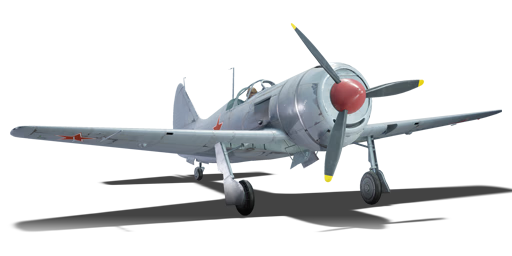


The La-11 was a late propeller fighter developed as an improved version of the La-9. Initially named as La-130, the aircraft was further enhanced based on VVS recommendations and renamed as La-9M. With increased fuel capacity and weight, it was later certified as the La-11 in 1947. However, by 1951, with the rise of jet fighters, the La-11 became obsolete. It had limited combat success and was primarily used as a trainer. The aircraft found second life with Soviet allies like the KPAF and PLAAF before being phased out in favour of jet fighters.
It was introduced as a premium pack in Update 1.65 "Way of the Samurai" and was removed from the store after the 2018 Summer Sale. It was again made available briefly as part of the 2021 Summer Sale. The La-11 being a long range version of the La-9 is heavier, however its flight performance is very similar, but this only happens with light fuel loads. Its engine performs better at low altitudes, so stay below 4000m to increase engine output. The armament consists of 3 x NS 23 cannons which are excellent for dealing with enemy aircrafts and can consistently destroy bombers and heavy fighters.
flaps
flaps
flaps
brake
| Belt | Belt filling | Armor penetration (mm) at a distance: | |||||
|---|---|---|---|---|---|---|---|
| 10 m | 100 m | 500 m | 1000 m | 1500 m | 2000 m | ||
| AP-I/FI-T | 32 | 30 | 22 | 15 | 10 | 7 | |
| FI-T/AP-I/AP-I/AP-I | 32 | 30 | 22 | 15 | 10 | 7 | |
| FI-T/FI-T/FI-T/AP-I | 32 | 30 | 22 | 15 | 10 | 7 | |
| AP-I | 32 | 30 | 22 | 15 | 10 | 7 | |
| Belt | Belt filling | Armor penetration (mm) at a distance: | |||||
|---|---|---|---|---|---|---|---|
| 10 m | 100 m | 500 m | 1000 m | 1500 m | 2000 m | ||
| AP-I/FI-T | 32 | 30 | 22 | 15 | 10 | 7 | |
| FI-T/AP-I/AP-I/AP-I | 32 | 30 | 22 | 15 | 10 | 7 | |
| FI-T/FI-T/FI-T/AP-I | 32 | 30 | 22 | 15 | 10 | 7 | |
| AP-I | 32 | 30 | 22 | 15 | 10 | 7 | |







 2 x (100 / 230 / 480) %
2 x (100 / 230 / 480) % 
 2 x 172 %
2 x 172 % 

Flight performance | |
|---|---|
Survivability |
|---|
Weaponry |
|---|